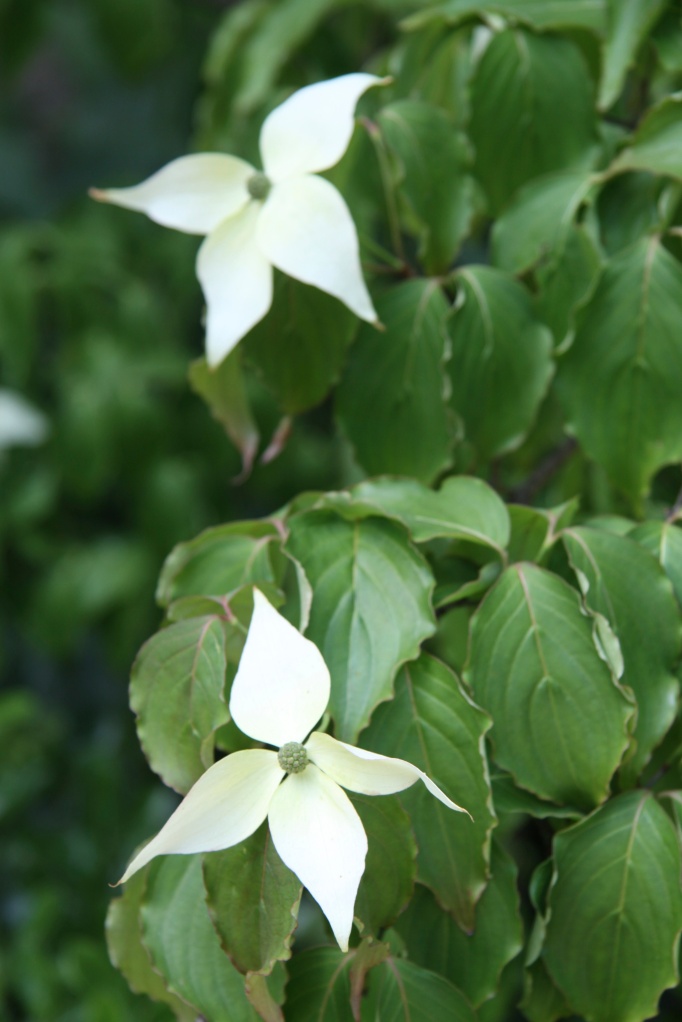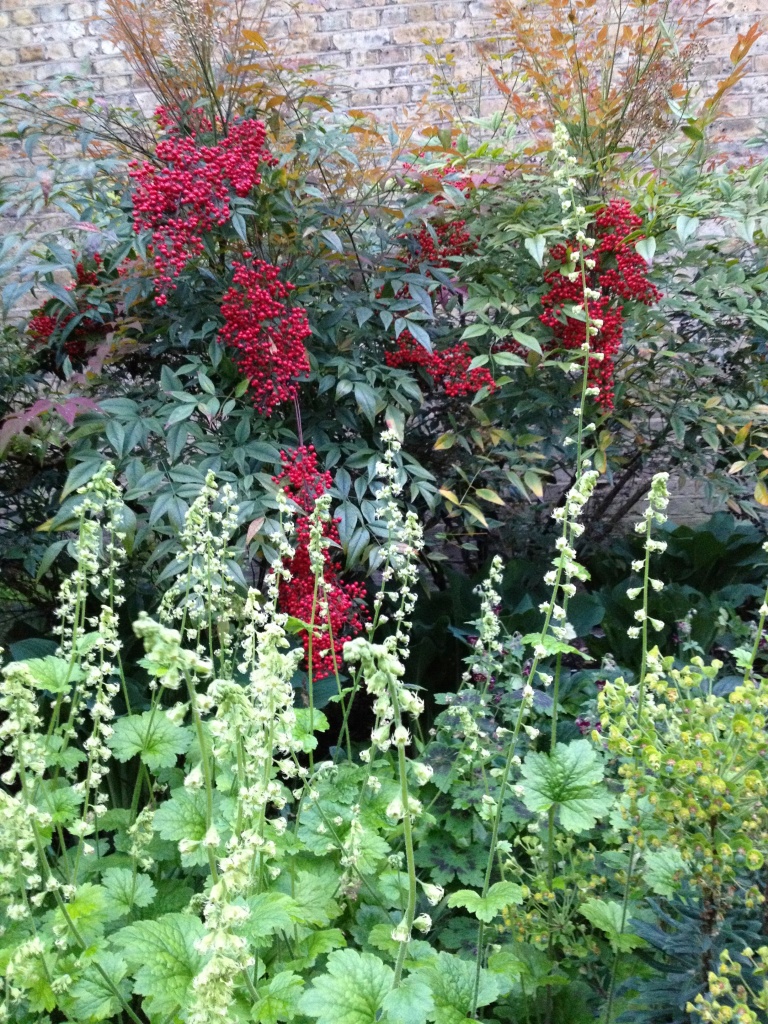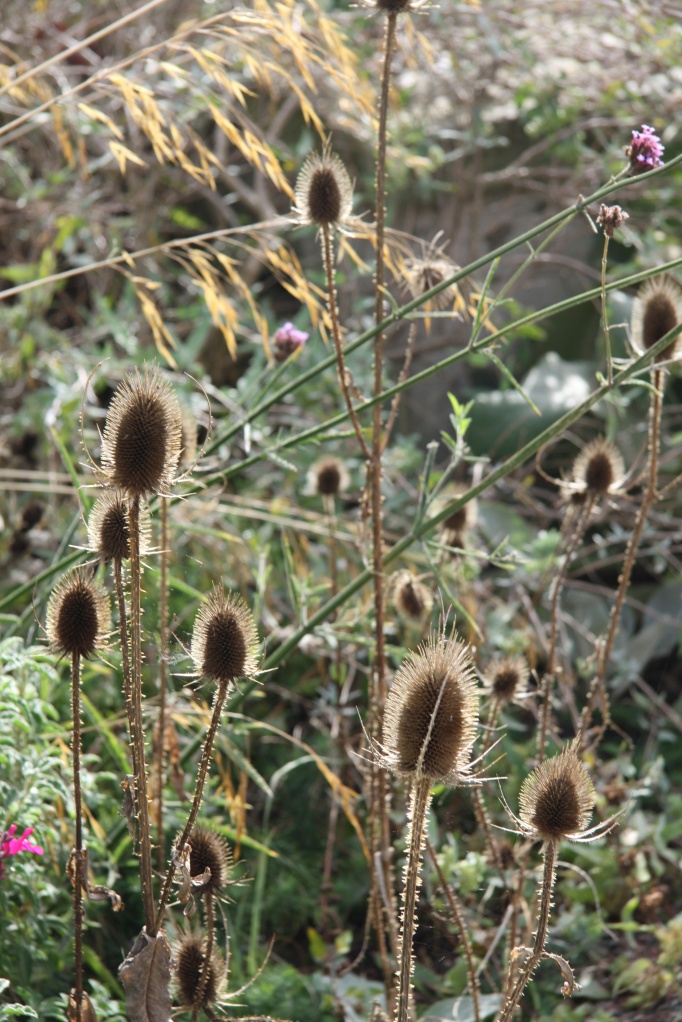INTIMATE PLACES TO SIT – AND MAYBE EAT YOUR LUNCH – SURROUNDED BY PLANTS IN THE CITY
Vibrantly planted urn at the centre of the Garden of St John’s Lodge
You are walking through the imposing Avenue Gardens in Regent’s Park. Maybe you are on your way to the Frieze Art Fair, or to the zoo or returning from a doctor’s appointment or a shopping trip. There is something gracious and international – Parisian almost – about the perfect symmetry and the monumental scale of the avenues and the formal gardens which flank them but you might feel a little lonely here amongst the glowering, repeated foliage and inky topiary sitting on a bench unwrapping your lunchtime sandwich:
 Regent’s Park, London
Regent’s Park, London
 Regent’s Park, London
Regent’s Park, London
 Avenue Garden, Regent’s Park London
Avenue Garden, Regent’s Park London
If you move away from the immaculate paths you will of course come across some gorgeous surprises – when I visit a few days ago, the ripening fruits of this strawberry tree, Arbutus unedo, has the brilliant primitive energy of a Henri Rousseau painting:
 fruits of Arbutus unedo – the Strawberry Tree
fruits of Arbutus unedo – the Strawberry Tree
And it is exciting to venture further off the main drag (just off the Inner Circle near to the junction with Chester Road) and discover the peaceful, intimate Garden of St John’s Lodge.
St John’s Lodge was the first elegant white stucco villa built in John Nash’s Regent’s Park. The house, finished in 1819, was originally (and is now again) a private residence, but it has had various other lives as headquarters of the RNIB and as Bedford College, London University. In 1888 the then owner, the 3rd Marquess of Bute, commissioned Robert Weir Schultz to create a garden ‘fit for meditation’. The garden – with its feeling of enclosure, a series of comfortable garden rooms around a circular central space – has been open to the public since 1928 when the Cabinet decreed that more of Regent’s Park should be accessible to Londoners.
The garden was renovated by Colvin and Moggridge in 1994 and the style of planting is as soft and natural as the outer world of the Park is restrained and formal. Even at the end of October vibrant mounds of Erysimum ‘Bowles Mauve’ spill over onto the sunken lawns.
 A high backed wooden bench surrounded by geraniums, Viburnum davidii, and ferns
A high backed wooden bench surrounded by geraniums, Viburnum davidii, and ferns
There are handsome high backed wooden benches, sensitively set apart from each other and enclosed in wonderful arbours of green. In summer the generous benches are framed with trailing clematis and wisteria. In autumn they are still encased in a booth of green: a classic but enduringly effective combination of geraniums, glossy Viburnum davidii and ferns. Here the bench itself is rather brilliantly underplanted with Sarcococca confusa – Christmas Box – which will provide a delicious, secret supply of heady scent in late winter.
I am running late and trying to leave the garden with a view to returning as soon as I can, when my eye is drawn to the brilliant coral planting of a huge urn, glimpsed through an arch formed in a hedge of lime trees, with white Japanese anemones lining a tunnel-like path and luring me to come closer.
Giant urn enclosed by a circle of Limes, Garden of St John’s Lodge
I cannot resist and move forward to take a look. As I approach the fringe of back-lit, lime leaves glows a brilliant green:
 The urn seen through a fringe of brilliant green lime leaves
The urn seen through a fringe of brilliant green lime leaves
The winter planting of the urn is not quite finished but it is rather sensational: young plants of Cornus sanguinea ‘Midwinter Fire’ amongst salmon, plum and toffee-coloured winter pansies against a densely scalloped backdrop of dark green:
 Close up of the urn with Cornus sanguinea ‘Midwinter Fire’, winter pansies and trailing ivy
Close up of the urn with Cornus sanguinea ‘Midwinter Fire’, winter pansies and trailing ivy
Clutching my new London secret garden to me, I walk down the hill that evening with my family to our brilliant local cinema, Peckham Plex. I am thrilled to see that my evening of enjoyable but ridiculous adventure (Gone Girl) is made sweeter by the sudden arrival of ‘Rye Lane Orchard’ – a series of fruiting trees in galvanised metal containers that now line the unglamorous path between McDonald’s and the cinema:

Rye Lane Orchard, Peckham

Rye Lane Orchard, Peckham
There are red and white stripey benches to perch on while waiting for a friend:
 Perching Bench, Rye Lane Orchard
Perching Bench, Rye Lane Orchard
Or two of you could arrange to meet up and have a drink or a chat:
 Bench for two in Rye Lane Orchard
Bench for two in Rye Lane Orchard
I love the gentle orange red of the crab apples against the harsher 1970’s brick buildings:
 Close up of Crab Apples, Rye Lane Orchard
Close up of Crab Apples, Rye Lane Orchard
I like the simple, thorough, industrial style of the labelling:
 And I like the way that you can quietly find out more about how the trees got here if you want to:
And I like the way that you can quietly find out more about how the trees got here if you want to:

And the slightly out of place – but hats-off-for-trying – addition of recipes and information about the trees :

When I get home I do want to know more. I find out that the ‘Orchard’ arrived in fact in April 2014 and will remain as part of an experiment in enriching this urban, bustling part of South London with plants for a couple of years. It was originally part of ‘Octavia’s Orchard’, an innovative 2013 collaboration between The South Bank, The National Trust and architects, ‘What if: project’ – for which a greater collection of trees and benches spent the summer on the South Bank. I am intrigued to learn that the original project was named for Octavia Hill who not only founded the National Trust but also campaigned powerfully for everyone to have access to green spaces “the sight of sky and of things growing” – I had not known that securing public access to Parliament Hill FIelds, Vauxhall Park and Brockwell Park were just some of her triumphs. If you think the National Trust is too cosy, even slightly old fashioned it is worth remembering Ms Hill’s founding fire nearly 120 years ago: “Destruction of open spaces is imminent because we are all so accustomed to treat money value as if it were the only real value”.
 The Fox Garden, South London Gallery, in May – the path lit up with Libertia grandiflora
The Fox Garden, South London Gallery, in May – the path lit up with Libertia grandiflora
Elsewhere in Peckham there is another secret garden you should know about – The Fox Garden at the leading contemporary art gallery, The South London Gallery. I have to come clean that this is a garden I am closely involved with (I designed the planting for the garden with my partner, Helen Fraser) and it is one of our favourite projects. It is such a beautiful space – flanked on one side by the towering wall of the original Gallery, (opened in 1891 – around the same time that Octavia Hill was gearing up to co-create the National Trust), and framed at each end by the elegant Clore Studio and No. 67 Cafe, designed by 6a architects. Also, and perhaps most importantly, the garden is open to everyone, every day except Monday, and like the Gallery itself, free to visit. It was the vision of gallery director, Margot Heller, that led to us becoming involved: she was adamant that this was an opportunity to provide a surprising seasonally rich garden within the gallery walls, only steps away from the gritty reality of Peckham Road.
Here, on simple oak benches , you can eat your lunch surrounded by a palette of plants which changes significantly as the year progresses:
 The rich palette of The Fox Garden in January – Libertia grandiflora foliage and the red berries of Nandina domestica
The rich palette of The Fox Garden in January – Libertia grandiflora foliage and the red berries of Nandina domestica
The same Nandina in spring, this time illuminated by the pale spires of Tellima grandiflora
 Pale claret flowers of Geranium phaeum with skinny green spires of Heuchera cylindrica in May
Pale claret flowers of Geranium phaeum with skinny green spires of Heuchera cylindrica in May
 June: the beautiful milky bracts of the enormous Cornus Kousa var. chinensis that fill the glass windows of the cafe.
June: the beautiful milky bracts of the enormous Cornus Kousa var. chinensis that fill the glass windows of the cafe.
The garden surprises with scent too at different times of year – mounds of Sarcococca confusa flank the path at each end of the garden and the scent of Philadelphus fills the space in June. And of course sometimes an artist will want to use the garden as part of the Gallery space itself. Until 23 November 2014 you can eat your lunch contemplating the elegant, swooping ‘wall sculpture’ by Lawrence Weiner – part of his ALL IN DUE COURSE exhibition in the main gallery:
Lawrence Weiner wall sculpture on expansive Victorian Gallery/Fox Garden wall

Close up Lawrence Weiner wall sculpture on SLG Gallery/Fox Garden wall
A short journey away by train and tube is the place to find London’s most brilliantly colourful benches to sit and eat on:
Bench surrounded by `Salvia uliginosa, Salvia involucrata ‘Bethellii’ and Rudbeckia
 Bench with Miscanthus sinesnsis, Salvia leucantha and Salvia involucrata ‘Bethellii’ spilling over
Bench with Miscanthus sinesnsis, Salvia leucantha and Salvia involucrata ‘Bethellii’ spilling over
This is the garden of the Inner Temple which is gardened with wonderful energy and originality by Head Gardener, Andrea Brunsendorf – and is a place not only for learned, dark-suited lawyers to come into the sun for a few moments but is again open to everyone from 12.30 to 3.00 each weekday:
Andrea is well known for her exuberant late summer borders (but please check out the garden at tulip time and come again to see the Peony Garden in full bloom). Here in late October, the borders make you smile with their exuberance:
 You can tell the way it is gardened by the relaxed bearing of the self seeded verbascum on the garden steps:
You can tell the way it is gardened by the relaxed bearing of the self seeded verbascum on the garden steps:
 Self seeded Verbascum on Inner Temple Garden Steps
Self seeded Verbascum on Inner Temple Garden Steps
And by the celebratory way the Verbascum petals are allowed to linger like stars on the stone steps:
 Individual Verbascum flowers against stone
Individual Verbascum flowers against stone
Peak through the railings on your way to court and you will catch the orange flash of tangled mexican sunflowers – Tithonia rotundifolia :
 Or you might stop to admire silky clematis seed heads spilling out onto the pavement:
Or you might stop to admire silky clematis seed heads spilling out onto the pavement:
 Clematis seedhead
Clematis seedhead
Or maybe you will wonder – as I did – about the amazing shrubby plant flanking the entrance with tulip shaped leaves and yellow pea like flowers?
Amicia zygomeris flanking the steps
Close up of Amicia zygomeris
Andrea kindly put me out of my misery and revealed this plant to be a fantastic woody-based perennial which can survive a temperature of -14 degrees celsius (it will regenerate if cut down by frost) – a brilliant, or as Christopher Lloyd puts it ‘unexpectedly stylish’ foliage plant for a courtyard garden. I remembered in fact that there is the most beautiful stand of this Amicia in the Exotic Garden at Great Dixter – I had been drawn to the purple veining of its leaves and stipules but had never seen it flower …
 Amicia zygomeris at Great Dixter
Amicia zygomeris at Great Dixter
Walking down the steps to the main body of the garden the autumn sunshine has a magical dancing effect on the surprisingly relaxed planting on either side:
 Miscanthus sinensis ‘Unidine’ with Verbena hastata ‘Rosea’
Miscanthus sinensis ‘Unidine’ with Verbena hastata ‘Rosea’
Teasels back lit by the autumn sunshine
Here you will find quieter, shadier places to sit: I loved this benches’ backdrop of Begonia grandis subsp. Evansiana
Begonia is not used often enough as a late flowering plant for shade: in the Inner Temple Garden it is brilliantly and simply combined with Hydrangea arborescens ‘Annabelle’:
Begonia grandis subsp. evansiana with Hydrangea arborescens ‘Annabelle’

 Close up elegant flowers of Begonia grandis subsp. Evansiana
Close up elegant flowers of Begonia grandis subsp. Evansiana
There is one further, perfectly positioned bench, a quiet bench in an arking canopy of just turning greens and yellows:
This bench reminds me suddenly of my fig tree at home – that fantastic moment between green and yellow:
 I realise I will be back here again tomorrow. Just round the corner is the Temple Church where one of my sons is singing. I love these connections between art and gardens and film and trees and gardens and music. Come to the concert tomorrow and try to visit the Inner Temple Garden whenever you can.
I realise I will be back here again tomorrow. Just round the corner is the Temple Church where one of my sons is singing. I love these connections between art and gardens and film and trees and gardens and music. Come to the concert tomorrow and try to visit the Inner Temple Garden whenever you can.

















I was at the Inner Temple garden earlier this year and discovered it had a wonderful mulberry tree – not sure if it can be scrumped in front of all of those lawyers though! I discussed the new experimental grass underplanting some of the trees with Andrea – very interesting.
I also saw the original Octavia’s Orchard last year – here’s another bench for you from that…
http://signothetime.wordpress.com/2013/08/09/friday-bench-octavias-orchard/
and an explanation of the festival:
http://vegplotting.blogspot.co.uk/2013/08/roll-out-barrows.html
I hope you don’t mind me adding a couple of URLs for you and I hope you find them interesting if you decide to look them up.
Thanks so much for writing to me about my post – yes the mulberry tree in the Inner Temple Garden is particularly lovely. Thanks for more info about Octavia’s Orchard and the festival as a whole. Such a great project – simple and really effective. Very best wishes, Non
Pingback: WHAT I LEARNT FROM THE CROCUS KING | The Dahlia Papers